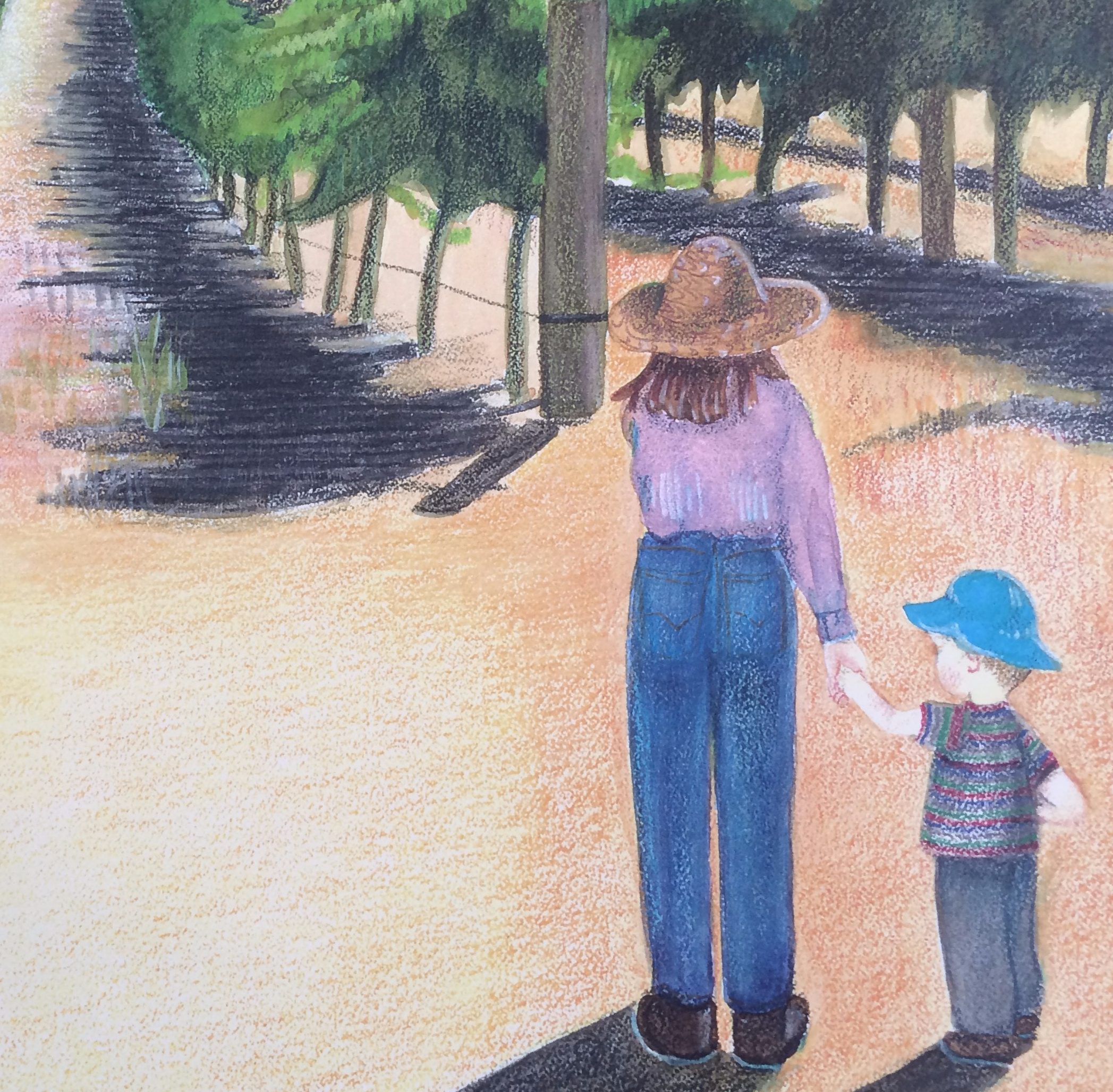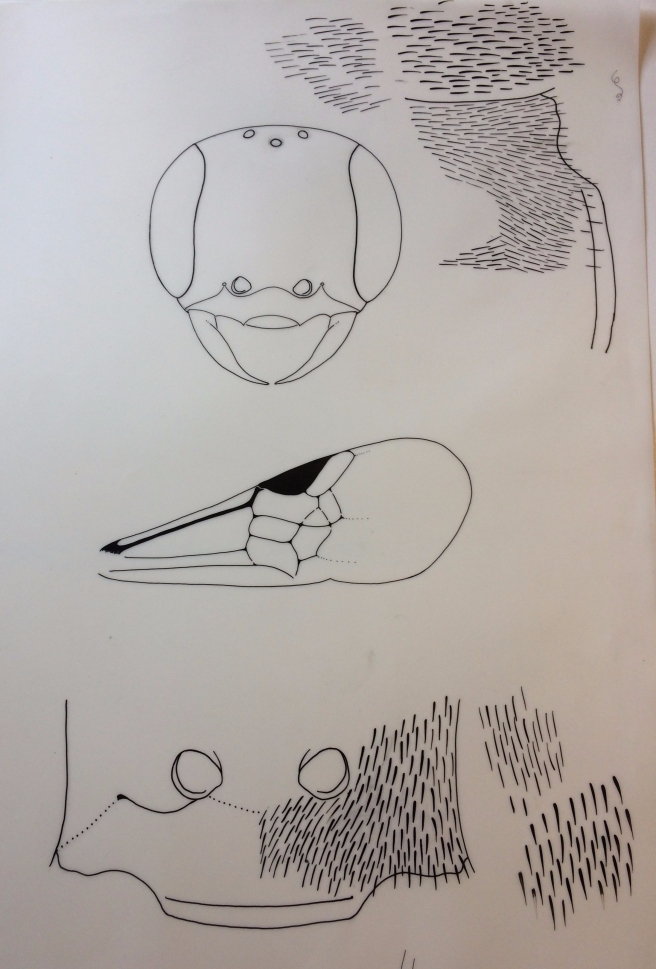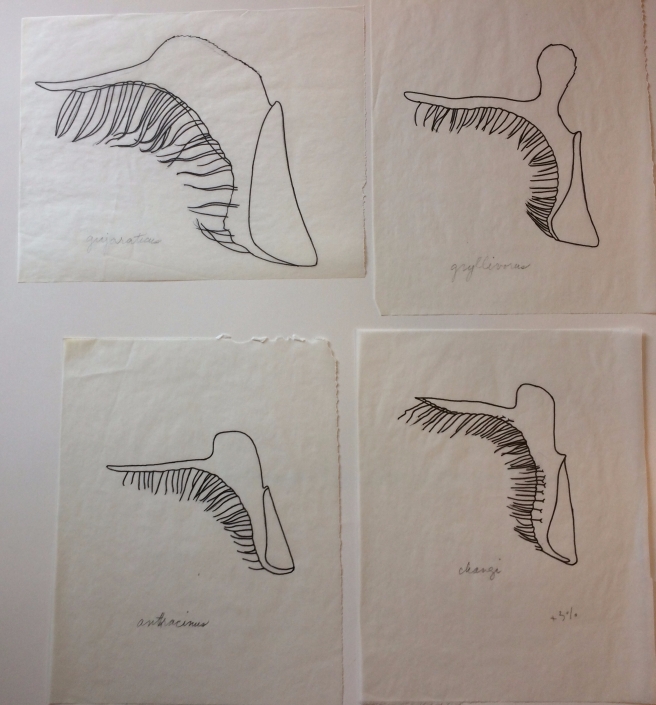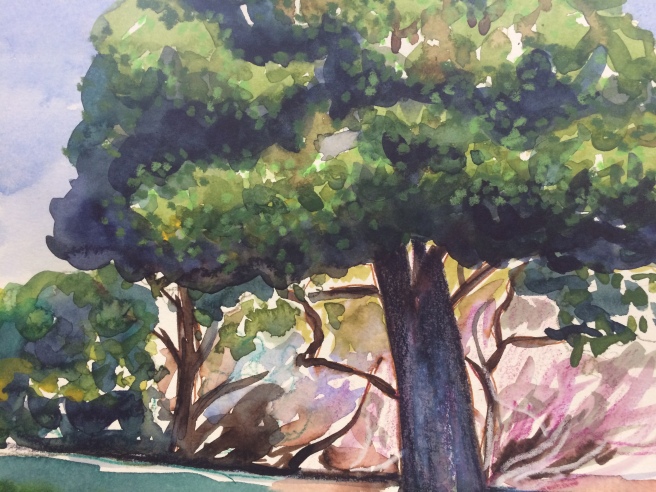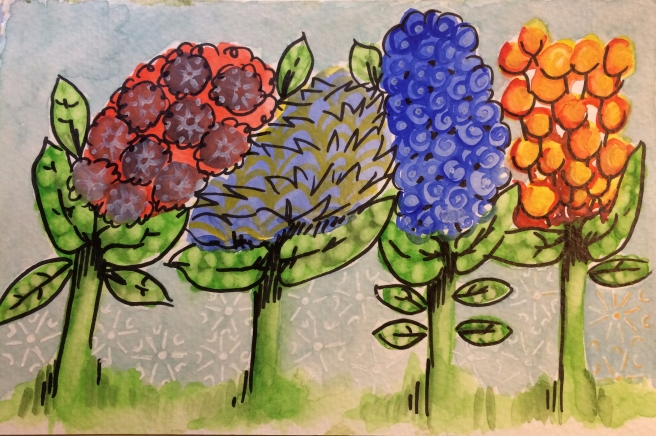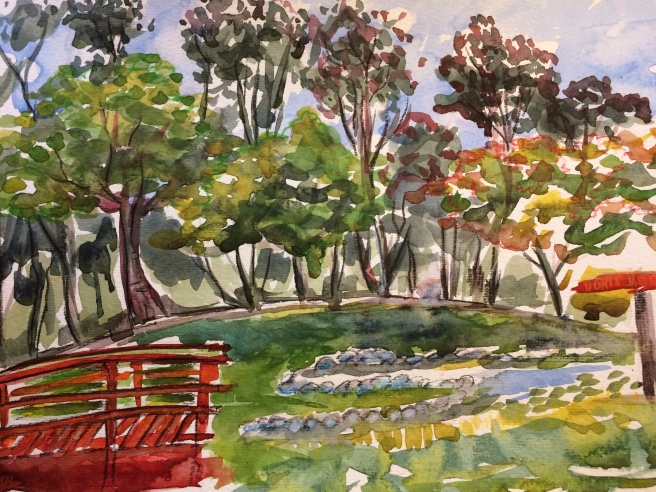
I guess I can’t seem to get out of the rose garden at the Descanso, and I just give up that I will paint anywhere else when I’m there—at least not in the foreseeable future. That part of the garden was just so full of such tantalizing spring colors and all. My mind was so full of ideas of how to capture those amazing pink spring blossoms and the new growth on the roses. Whatever! I give up! (If you haven’t read my blog before, I am lamenting the fact that every time I go to the Descanso Garden I always head for the rose garden to paint.) Oh well. So, before I begin to describe my color choices for this piece I should mention that I was trying out a new watercolor paper. (Actually it’s not watercolor paper at all, but rather a paper for mixed media.) It was ok, but I think I prefer that watercolor paper have more texture than this. It was pretty flat, with no little knobs or dents to obstruct the flow of the paint. In my opinion washes are more interesting when the paper has a subtle texture especially when rendering the sky—with clouds or a cloudless blue.
But my real intent was to use all of the red and pink colors in my watercolor cakes and tubes, as well as my watercolor pencils to render all of the flower petals and shiny new leaves in the rose garden that day. So, listed here are those colors and a few notes I made for each one I used:
Watercolors:
- Chinese White
Small amounts of: Scarlet Lake, Cadmium Barium (red, medium), Cadmium red (light), mixed with sap green with some of these reds to make the trunks/branches of some trees
- Alizarin Crimson (tube and cake): Blossoms mostly, but touched the sky as well
- Opera
Watercolor pencils:
Inktense pencils: poppy red, fuschia
Staedtler watercolour pencils–#61, #23
I almost never use a color straight from the tube or in a cake; I just have to add a little something else to every pot of color I make. Not sure if any of you out there use colors just as they come, or if you are like me and just have to fiddle around to make the perfect color, or make the perfect allusion of a color. I thought it worth some thoughts and words about the making of a color like pink, as I think it can go so wrong very quickly. I am such a nut about my blues and greens, so of course I must obsess about pink as well. There are a couple ways I get “Descanso Garden pink.” I usually start with a diluted and pale red color so I can layer more pigment later if I want. I also like to leave white space around the pink as I think it brightens the color as though it’s a highlight. I also like to suggest intensity with spots of scribbled bright watercolor pencil. Sometimes I leave it raw and sometimes I soften and swirl it around with a dab of water. I did that on the blossoms of the two trees to the right and the new growth of the rose in the foreground.* I don’t often add white to my watercolors, let alone to any of my “go to” reds (pretty mad about alizarin crimson in watercolor and oil paints as well) to make pink. Not really sure why I hold back the white pigment (gouache in this case). I am willing to mix huge amounts of white to my oil paints, no problem. Somehow I am OK with that because they are all still oils, where watercolors (transparent) and gouache (opaque) are different. It always feels like I’m cheating or trying to cover up a mistake when I add white. I feel like I should be able to use the white color of the paper underneath or beside the pigment to lighten the load of such a color, not cover it up. For this piece I did mix some Chinese white with my diluted red to make the blossoms in the shrub in the middle. And I like it. I have one exception to my seemingly crazy rules of mixing paint and pink and that is the color “Opera.” I do use that one straight from the tube. I didn’t use it in all its glory here, but I did spread it around quite liberally when I painted a friend’s bougainvillea summer before last.
* I don’t usually identify plants in my work as the two trees on the right or the shrub in the middle. I usually get up and look at the printed name stakes staked under each plant I am drawing. I mean, that’s what I love about places like the Descanso Garden or Huntington Botanical Garden, they have markers with names under all roses, trees and shrubs. Don’t know why I didn’t go and look on that day. I will definitely do that the next time I’m there.
People don’t often stop by when I am working, and I am actually kind of glad to not be distracted. But on that day a man and woman walked slowly past as I had just finished my large watercolor primary and secondary washes and blobs of watercolor foliage on the paper. I was thinking of taking a break to eat half of my peanut butter sandwich. They were about 8 feet away and didn’t really stop, but slowed their pace a bit to comment on what I was painting. Both said they thought it nice, but the man went further and said I should consider stopping as it was done. Of course I was thinking, “What did he mean by that?” I had so many more plans to add color and detail with my watercolor pencils. But I waited till they were way out of range, stopped, and stood back about 8 feet to see if he was right. I usually do this at various times of each watercolor. At that distance I take off my glasses, imagining I am someone else, looking at my art through different eyes. It is always at about this time that I make a mental note of what areas seem to be working best and which need a bit more attention. And I have to say that even though I later added a bit more linear color and detail with my pencils, it really looks pretty much the same as before.
I have already mused and written about when an artist knows he or she is done with a piece of art. And I still have no idea how to tell when I am done. I just make myself stop. That sometimes coincides with running out of painting water and my starting to use my drinking water. On that day I had run out of painting water, decided I was done and began packing up. As I did so the on looker’s comments got thinking about how far away one must stand to really get the total impact of a painting? Of course I initially thought it shouldn’t really matter and should be up to the viewer. This is a free country, don’t I get to stand as close or as far away as I would like? (Assuming I haven’t gotten too close and a museum guard has come to escort me away…) So, I wondered about other painters and what they might consider the optimum distance one should stand when looking at one of their finished works. I mean, if you get too close to a Van Gogh, all you see is brush strokes. And while that is pretty wonderful to look at, I would imagine he wanted you back a few feet to get the full affect of one color next to another, so your brain can magically mix them together in your mind. And Monet’s water lilies take up whole walls and getting too close to one of those pieces just doesn’t have the impact of standing way back. And I am certain that more contemporary artists, like Jackson Pollack, really wanted you to stand a good distance away to get the full affect of his large abstract canvases. Maybe when a painter decides to do a large piece, they are kind of daring you to get too close, knowing full well you will be compelled as if by some great force to take several paces back. This can sometimes be a very frustrating and selfish trick the great artists play on us. For example, last winter (2016-2017) the Norton Simon had Van Gogh’s “Bedroom” on Loan from the Art Institute of Chicago. That happens to be a real favorite of mine and I went to see it on a Friday evening during that time. There were so many people trying to get a good view of it, that I never got a real good look at it. I wanted to look close at the brush strokes and then step back until I was at the optimum distance I am sure Van Gogh wanted me to stand. But inevitably someone would see this space I had created and walk right into it. I tried to pretend that it didn’t matter, look through them and hope that he or she would soon be gone. But of course someone else joined that person, and so on and so on, until I finally walked away. I tried several times to go back and look at it again, but it was always the same thing. How do you look past someone with a stroller, or two friends with two strollers? So unfair and frustrating!
I hope to someday see Leonardo’s “Mona Lisa” in the Louvre. But I think he has played the ultimate trick an artist can play on all of us because that one is so small. (I just looked it up and it’s 2′ 6″ x 1′ 9.”) It’s also behind bulletproof glass (can’t blame Leonardo for that), which probably means there is some kind of glare when looking at it from some angles. To really see that one you would probably need to start out pretty close and then move a bit to each side to get the perfect view of her smile. And what are the chances that anyone will get out of your way so you can actually do that? (Such a whiner, I know.) I decided that’s when it’s probably good to be rich and famous, so you can pay to have everyone moved out of the way to get a good look. Not that any of my little watercolors could compare with the Mona Lisa, but I like to create art that would get your attention from across the room. And I don’t want the viewer to be gypped with just one perfect viewing distance to get the true affect of one of my little landscapes. I try to have a little something for everyone in my little works at every angle, just like this one. So I add small details of lines and scribbles of color that you can’t actually see unless you get closer. So, if any of my art is ever hanging in the Norton Simon or at the Louvre you will be able to enjoy it from many different angles. Of course if it happens to be under bulletproof glass or there are just too many people with strollers, you are on your own!
